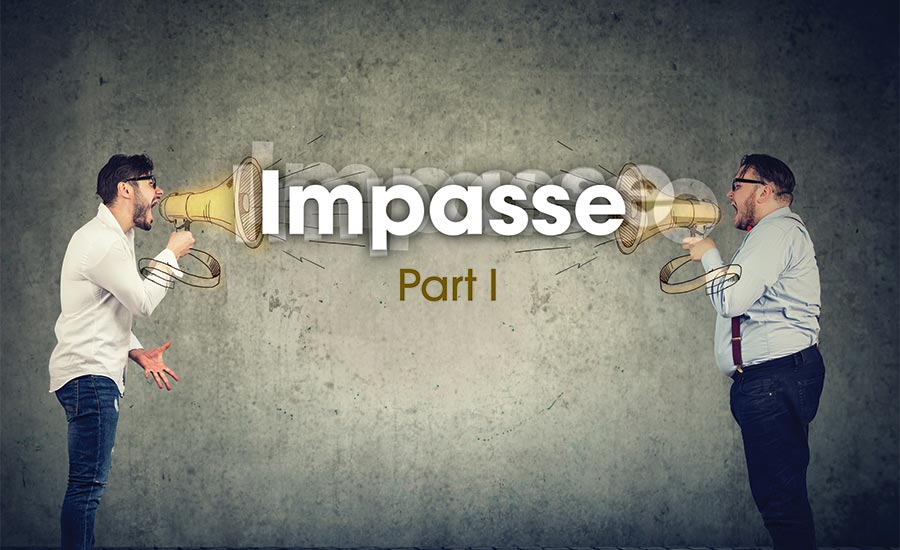I hate being backed into a corner. Whether it’s an employee trying to hold you hostage for a raise or an insurance adjuster standing his ground on the payment of a claim, there is a feeling of helplessness and lack of control which is enough to drive most Type A personalities crazy. This can lead to anger, resentment, and more often than not, regrettable actions.
Most business books and articles written on negotiation focus primarily on the process and reaching effective agreements in ways that support and/or enhance the relationship between parties. But what happens when those strategies are exhausted and negotiations become locked in a stalemate? Or worse, your counterpart is making unreasonable demands or requests while refusing to hear other options?
If this sounds familiar, you’re not alone. Insurance carriers specifically like to take the role of the positional bargainer, using the terms of the policy or claims department “rules” as a basis for a “take it or leave it” position. This is often accompanied by the presentation of supporting information, consultations, or competitive estimates that are selectively favorable to their position.
In these situations, it is very tempting to tell the customer to start looking into the Alternative Dispute Resolution (ADR) clause in their insurance policy. These options can include appraisal, mediation, and arbitration. On more than one occasion I have also been known to ask an adjuster if he/she would like to explain to the customer why they don’t have enough money to pay for the services provided or if they would like me to do so. Regardless of how effective these alternatives can be, they are not very productive when it comes to preserving relationships.
There are options for dealing with an impasse, and they fall broadly into three categories: give in, say no, or do nothing. When considering which option to choose, we must remember two things: the importance of the outcome and the importance of the relationship with the stakeholders. Authors Roy J. Lewicki and Alexander Hiam use this in their book, Mastering Business Negotiation, to explain how to select an appropriate negotiation strategy. We can use this same philosophy to consider how to deal with common stalemate situations.
Giving In
Choosing to fold like a deck of cards and give in to the counterpart’s demands is only effective if there is an extremely high degree of value on the relationship and low value on the outcome. This is common when the referral source for a project is critical to a future volume of work or if there is a personal relationship between stakeholders that cannot be compromised. It is a lose-to-win option, where the contractor is surrendering the battle for a chance to win the war.
Aside from having a strong desire to win, I don’t like the option of giving in mainly because of the precedence it sets. I believe it sends the wrong message to external stakeholders and opens a Pandora’s box of future one-sided negotiations. It can also confuse internal stakeholders, giving them the impression that the bargaining criteria is not important. This could lead to poor decision-making and unauthorized concessions on future projects.
Say No
No is my favorite word in business. I actually had a client make a name tag for me one time with the word “No” written below my name. Most restorers, however, are conditioned to say “Yes” from the very first phone call on a new project. They are taught to have a servant mentality and to make customer satisfaction the top priority in everything they do, including negotiating. While most would not dispute the importance of customer satisfaction in a service industry, this can lead to less-than-effective negotiations. Especially when an impasse is reached.
When done correctly, saying no can be an effective strategy to break a deadlock when the value of the outcome is high, but there is little to no value in the relationship. Saying no correctly involves a three- step process:
- Acknowledge the counterpart’s position.
- Say “No” politely.
- Offer alternatives.
Here’s an example of what this might sound like when negotiating with an insurance adjuster: “Mr./Ms. Adjuster, I understand your claims department has estimating guidelines they must adhere to, and I would not want you to jeopardize your position with the company. Unfortunately, if we follow those guidelines for this project, it will not afford us the ability to restore the loss in a manner that will satisfy the customer (insured). Perhaps another contractor might be able to accommodate your needs better.”
Saying no is a lose-lose option. And while walking away from a project might be an effective solution in this situation if you are willing to sacrifice the relationship for your position, it still leaves you without a deal and the possibility of damaged relationships with the external stakeholders. While I believe that restorers need to do a better job of saying no in today’s market, it is my opinion that this option should be reserved for situations where the project doesn’t meet the contractor’s requirements for being successful.

Do Nothing
We all know the worst decision in business is indecision. I am not going to dispute that; however, I will add that nothing moves parties off their position better than time. The longer a stalemate continues, the greater the risk for both parties. This increased risk jeopardizes both the value of the deal and the relationships equally. This balanced menace can create opportunity to break the impasse as long as the ball is in the counterpart’s court.
To exercise the do-nothing option, we first need to know if the counterpart is a true decision maker or if they are just the messenger. If you are dealing with the decision maker—the one who has the authority to reach an agreement without seeking prior approval—things generally move faster and the tactic is simple: keep asking the counterpart for options until they present one that is acceptable to all parties.
If the counterpart is not the decision maker and they need to seek prior approval, the process is a bit more complicated and longer. Remember, don’t shoot the messenger! You need to show them some love, instead. This involves using an extreme amount of empathy. You must mirror their position and frame it in a way that creates a commitment to reaching a resolution.
In the claims adjuster example we used above, it might sound something like this: “I understand you are in a difficult position with this claim. Trying to please everyone in this situation must be very difficult. Perhaps we can develop some other options. Would you be willing to seek some alternatives from your supervisor that we could consider?” Now the messenger is negotiating on your behalf with the decision maker.
As you can see, doing nothing isn’t really doing nothing; it’s getting the counterpart to negotiate against themselves. This is common practice when buying a car. The buyer keeps shopping and asking questions while the salesperson keeps going back to the sales manager for a better deal. The longer the buyer does this, the better the deal gets. When the sales manager finally walks out of his/her office to meet the buyer, the best possible agreement has been reached.

Parting Lines
Regardless of which method is chosen to break an impasse, one underlying fact should be in the forefront of every negotiator’s mind: negotiation is between people. It is the people involved who created the criteria being bargained for and the rules in which they are bargaining. With this in mind, changing a counterpart’s perception is not possible without some degree of respect and even trust.
One of my favorite questions to ask during a negotiation is “How?” This is known as an implementation question. It forces the counterpart to justify the feasibility of their position within the parameters acceptable to you. This is a great parting line when it appears that a stalemate is inevitable. It can solicit additional options from the counterpart even when there don’t appear to be any left.
Another variation of this question was posed in a Forbes article written by speaker/author Lelia Gowland. She claims that a negotiation impasse can be overcome with just one question: “What would you do if you were me?” I like this parting line because it draws on the human elements which are so important to the negotiation process. If you put the two questions together: What would you do? … ANSWER, … and How? … you end up with a very powerful tactic to conquer the impasse.


